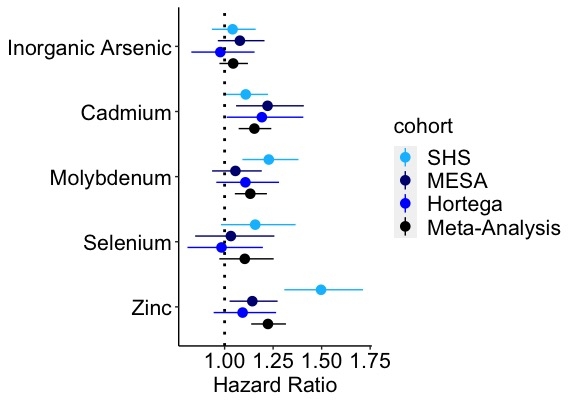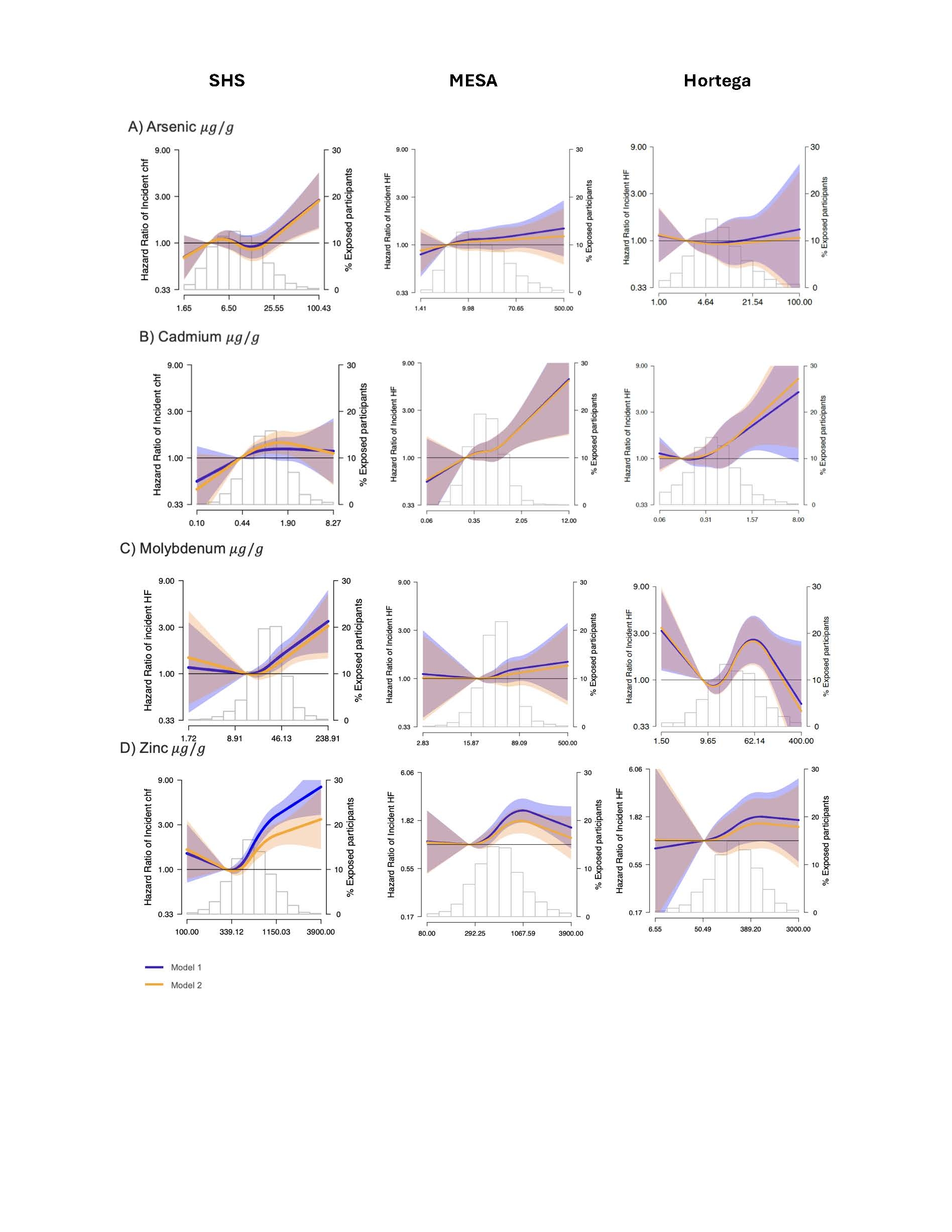Final ID: 044
Urinary Metals and Incident Heart Failure: A Multi-Cohort Study and Meta-Analysis
Objectives: To evaluate the prospective association of urinary metals on incident HF risk across three geographically and ethnically/racially diverse cohorts: the Multi-Ethnic Study of Atherosclerosis (MESA) and the Strong Heart Study (SHS) in the United States, and the Hortega cohort in Spain.
Methods: A total of 6,644, 2,917, and 1,334 adults 35-80 years old were included across MESA (39% non-Hispanic white, 27% non-Hispanic Black, 22% Hispanic/Latino, 12% Chinese-descent), SHS (100% American Indian), and Hortega (100% white), and followed up to 19 years. Urinary levels of inorganic arsenic, cadmium, molybdenum, selenium, and zinc were measured in all cohorts at baseline. The multi-adjusted (sociodemographic + clinical covariates) hazard ratios (HR) of HF per one interquartile range (IQR) difference in urinary metals were estimated for each metal using Cox proportional hazard models and a fixed-effects meta-analysis was run for each metal across cohorts. Flexible dose-response assessment was conducted using quadratic splines. We further estimated the HRs and 10-year-survival probability difference per IQR change in the mixture of five metals using Cox proportional hazard models with an Elastic Net penalty.
Results: A total of 425 (MESA), 477 (SHS), and 103 (Hortega) participants developed HF over the study follow-up. Significant associations were identified for arsenic (Pooled HR (95%CI): 1.06 (1.00, 1.12), cadmium (HR: 1.15 (1.07, 1.24)), molybdenum (HR:1.14 (1.03, 1.26)), and zinc (HR: 1.23 (1.02, 1.49)) in the meta-analyses (Figure 1). A largely linear dose-response was identified for arsenic and cadmium (Figure 2). In fully adjusted models, the HRs (95% CI) and 10-year survival probability differences (95% CI) of incident HF per one IQR increase in the metal mixture were, respectively, 1.38 (1.00, 1.86) and -0.40 (-0.78, 0.00) in MESA, 1.55 (1.28. 1.97) and -1.24 (-2.20, -0.59) in SHS, and 1.08 (0.85, 1.63), and -0.03 (-0.21, 0.06) in Hortega.
Conclusion: This multi-cohort study identified consistent associations between higher urinary metals and increased risk of heart failure across diverse populations, supporting the role of prevention strategies to reduce contaminant metal exposure to lower HF risk.
- Martinez-morata, Irene ( Columbia University , New York , New York , United States )
- Umans, Jason ( University of Washington , Seattle , Washington , United States )
- Cole, Shelley ( Texas Biomedical Research Institute , San Antonio , Texas , United States )
- Tellez-plaza, Maria ( National Center for Epidemiology , Madrid , Spain )
- Valeri, Linda ( Columbia University , New York , New York , United States )
- Barr, R. Graham ( Columbia University , New York , New York , United States )
- Shea, Steven ( COLUMBIA UNIVERSITY , New York , New York , United States )
- Devereux, Richard ( Weill Cornell Medicine , New York , New York , United States )
- Navas-acien, Ana ( Columbia University , New York , New York , United States )
- Domingo, Arce ( Columbia University , New York , New York , United States )
- Schilling, Kathrin ( Columbia University , New York , New York , United States )
- Glabonjat, Ronald ( Columbia University , New York , New York , United States )
- Mcgraw, Katlyn ( Columbia University , New York , New York , United States )
- Kaufman, Joel ( UNIVERSITY WASHINGTON , Seattle , Washington , United States )
- Post, Wendy ( JOHNS HOPKINS UNIVERSITY , Baltimore , Maryland , United States )
- Shimbo, Daichi ( COLUMBIA UNIVERSITY , New York , New York , United States )
- Fretts, Amanda ( University of Washington , Seattle , Washington , United States )
Meeting Info:
Session Info:
07. The Jeremiah and Rose Stamler Research Award Finalist Presentations
Saturday, 03/08/2025 , 01:30PM - 03:00PM
Oral Abstract Session
More abstracts on this topic:
Drenkova Kamelia, Lo Sicco Kristen, Berger Jeffrey, Garshick Michael, Kazatsker Filipp, Muller Matthew, Schlamp Florencia, Luttrell-williams Elliot, Liberow Sarah, Mcgirl Siobhan, Kennedy Lauren, Garelik Jessica
A Cardiac Targeting Peptide Linked to miRNA106a Targets and Suppresses Genes Known to Cause Heart Failure: Reversing Heart Failure at the SourceLu Ming, Deng Claire, Taskintuna Kaan, Ahern Gerard, Yurko Ray, Islam Kazi, Zahid Maliha, Gallicano Ian
More abstracts from these authors:
Li Weiyi, Fretts Amanda, Reese Jessica, Ali Tauqeer, Umans Jason, Cole Shelley, Zhang Ying
Comparison of Medicare Claims Recorded and Surveillance Identified Myocardial Infarction in the Strong Heart StudyWillmott Heather, Reese Jessica, Leidner Jean, Fretts Amanda, Ali Tauqeer, Umans Jason, Cole Shelley, Devereux Richard, Zhang Ying


